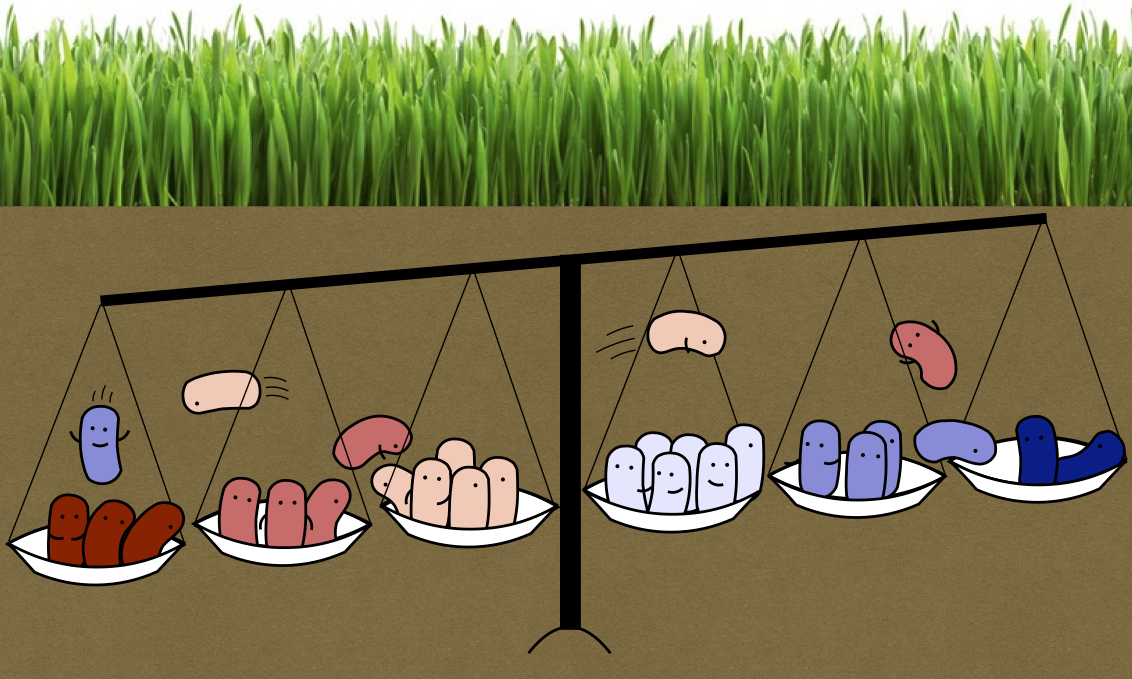Delayed adaptation favors coexistence
 When two species interact and adapt their fitness, only the fitter species survives. This is the case for well-mixed systems, as well as for metapopulations, in which smaller subpopulations are coupled by mixing or mobility. We show that in the latter case, both species can coexist when the species adapt their fitness to the environment with a delay.
When two species interact and adapt their fitness, only the fitter species survives. This is the case for well-mixed systems, as well as for metapopulations, in which smaller subpopulations are coupled by mixing or mobility. We show that in the latter case, both species can coexist when the species adapt their fitness to the environment with a delay.
Modern experimental protocols can identify ways in which microbial species can interact, produce or uptake nutrients, and how they adjust their phenotype accordingly. Both because of these methodological advances in identifying different species and their products, as well as due to a current interest in avoiding mass species extinction, studies increasingly focus on an easily accessible system where ecological diversity exists successfully: the striking ecological diversity of microbes in soil. One important feature of soil is that space is not homogeneous. Instead, pores of various sizes are coupled through different channels.
We investigate the impact of this population structure theoretically. In order to do so, we studied a simple model system consisting only of two species. We assumed that the species interact through a well-known interaction topology, namely via a simple exoproduct. This exoproduct is produced by only one species at a fitness cost, but is beneficial to both species. We expected the spatial structure of the population to be important for setups where different species produce or take-up external products in different ways: because the local composition of the species is different in every sub-environment or pore, the local environment can vary. Thus, when species move through the larger system by diffusion or mixing, they continuously experience different environments.
We assumed that species are fitter on pores in which more producer species are present, but that the moving individuals experience the changed environment with a delay (either due to metabolitic delay in the form of stored proteome, or to slow diffusion of the public good away from the producer): This delay means that species that move into a new environment remain in their old fitness state for a while before adjusting their fitness to that prescribed by the environment.
It is well-known that in well-mixed systems, the species that produces the public good dies out, because the public good production is associated with a fitness cost (commonly referred to as the 'tragedy of the commons'), even for nonlinear fitness functions. In the system of coupled subpopulations, we found that the delay causes both species to coexist for nonlinear fitness functions.
Coexistence occurs because the delay means that individuals with a series of different fitness values (corresponding to different local environments) exist in each subpopulation at any one time, and can keep each other in balance. We identify conditions, on only the fittest and least fit individual of each species, for when this balance can be maintained.
Remarkably, coexistence occurs for a large range of system parameters and especially for high mobility of species, i.e. where one might think that the system is trivially like a well-mixed system.Our work shows that the dynamics in spatially extended systems can be counterintuitive, and stresses the importance of spatially extended systems for biodiversity.
Related Links
- Phys. Rev. Lett. 121 (26), 268101 (2018): Delays in Fitness Adjustment Can Lead to Coexistence of Hierarchically Interacting Species
- LMU press release (German)
- LMU press release (English)

